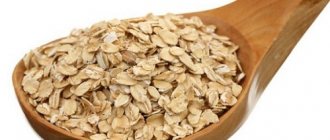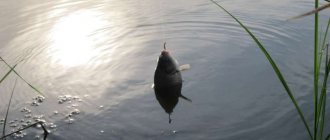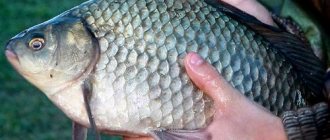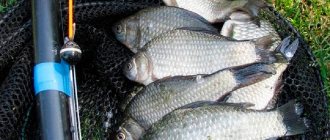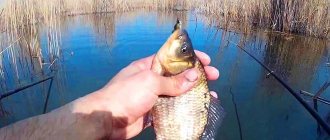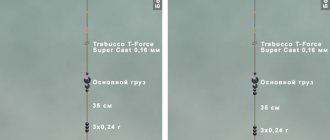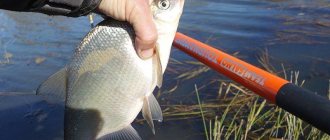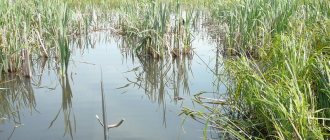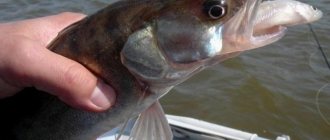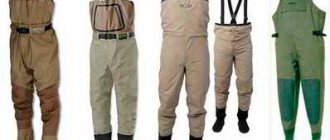Where to look for crucian carp in autumn
In the warm season, this fish prefers to stay in overgrown coastal areas, rich in various bottom animals. But with a decrease in water temperature (usually from the end of September), it begins to gradually move away from the shore to depth, occupying holes and other bottom depressions. The colder the water, the farther the heat-loving crucian carp moves, and anglers have to explore deep places in the hope of finding its camp.
In mid-autumn, you don’t even have to try to catch it in shallow water, where the water cools down much earlier. If you manage to catch a couple of lost crucian carp, it will only be by accident. And their size is unlikely to be valid. But a deep hole, strewn with snags, may turn out to be a real Klondike. Snagged areas with decent depth become a refuge for autumn crucian carp. In autumn, the density of this fish in such places is very high, and individuals of different ages and sizes are concentrated in them, so the chances of catching a trophy here are much greater.
Float fishing technique for crucian carp
The float rod allows you to fish at a depth of no more than three meters. Crucian carp mostly live closer to the bottom, so the float needs to be placed further away from the hook. This distance means the depth at which fishing is carried out.

To properly set up the equipment, you should first set the approximate expected depth and look at the position of the float. If it stands vertically, then the distance must be increased until the float moves to a horizontal position. This means that the hook is on the bottom and the distance between the float and the hook needs to be reduced a little.
catch crucian carp at night only in absolutely abnormal heat, when the water temperature “subsides” only at night. Then the crucian carp begins to act. But it is worth remembering that this only works in extreme heat; otherwise, night fishing for crucian carp does not involve any kind of catch.
The best fishing hours are midday with bright sun and gusty wind, at which time the food of crucian carp rises from the depths. There are also fans of night fishing, since at this time of day it is quite quiet and the crucian carp becomes active.
Finding a fishing spot
Crucian carp is very unpretentious and is found in many reservoirs. It can even live in ditches and swamps. Fishing sites can be classified into three types:
- Small lakes and reservoirs that dry up from time to time. There is very little food in them and almost nothing except crucian carp feeds. Of course, it’s impossible to catch big fish, but it’s not difficult to get a decent catch of small crucian carp.
- Large artificial or forest reservoirs filled with various fish. Here you can hope to catch a large specimen, but this is not so easy due to the presence of predatory individuals.
- Small rivers or estuaries where large and active fish are found. There, crucian carp either hide in creeks or migrate up the river.
Fishing from the shore
To catch crucian carp from the shore, it will be enough to use a fly rod.
Features of fishing on the river:
- If there are places equipped for fishing on the coastline, then it is better to settle there.
- It is good to fish in creeks, river branches and other places full of vegetation near the banks.
Features of fishing in still water:
- The optimal fishing spot is among the reeds.
- The crucian carp should be fed.
To avoid spooking the fish, it is important to remain quiet.
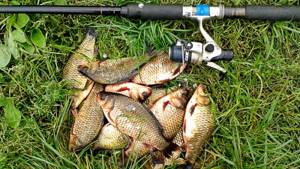
Fishing for crucian carp from a boat
Fishing from a boat involves deeper places, which means it would be better to use a mast fishing rod, about five meters long.
Features of fishing on the river:
- You can find fishing spots faster.
- Crucian carp lives in shallows far from the shore. It is usually full of algae vegetation.
- The bait should have a denser structure so that it does not get washed away by the current.
Features of fishing in still water:
- It is better to fish at shallow depths, up to one and a half meters.
- In still water it is easy to secure the boat in a fishing spot.
- Look for a place with changes in depth or vegetation.
Crucian carp and reeds
Like any aquatic plants, reeds are the most preferred places for crucian carp. There is plenty of food (flies, mosquitoes and other insects), a comfortable temperature, a good place for eggs and a lot of silt, which crucian carp like so much. It’s true that fishing here is not very convenient.
A number of difficulties arise:
- It is difficult to get to open water through the thickets;
- Additional equipment is needed (rubber suit and boat);
- Frequent cases of fishing line getting tangled in reeds.
A few tricky secrets for fishing in the reeds:
- You need to use a small fishing rod, with it there is less chance of losing the equipment in the grass. A fly rod with a rod size of approximately three meters is suitable.
- For the convenience of fishing, the reeds are cut to the water level, and directly in the area where the fishing rod is installed, they are simply bent.
- To understand whether there is crucian carp here, you should not immediately feed it, otherwise a bunch of all kinds of small fish will come running. First you just need to try to lure him out with a fishing rod and bait.
- When choosing a boat, it is better to give preference to rubber or wooden ones; they make less noise.
- The depth of fishing does not matter; crucian carp can be found everywhere.
Watch fishing for large crucian carp online
When does crucian carp bite?
Catching crucian carp with a fishing rod in the fall is somewhat different from similar summer fishing, primarily in that its feeding schedule changes. If September turns out to be warm, it can peck throughout the day, and sometimes at night. With the onset of the first cold weather, activity drops noticeably. Closer to October, there is no point in getting up at dawn and rushing to the pond, since only rare bites are possible in the early morning. A more or less stable bite begins at approximately 9.00 and continues until 18.00, sometimes until 19.00. That is, exactly as much as the sun shines, maintaining a certain air temperature.
The first serious cold spells will greatly affect the activity of crucian carp, but will not stop it completely. He will continue to eat in order to store fat for the winter, choosing the warmest hours for feeding - lunchtime. In November, the fished object still bites, but very rarely and sluggishly, and may ignore the bait given right under its nose. This month, autumn fishing for crucian carp with a fishing rod and other gear designed for fishing in open water stops until spring.
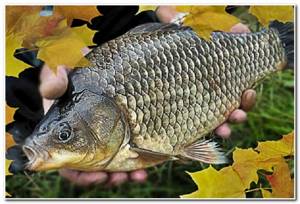
Choosing groundbait and bait for autumn crucian carp
When at the beginning of the article I praised crucian carp as an unpretentious fish for bait. I confess, I lied. Despite being omnivorous, crucian carp is a fish with a taste that can change even throughout the day. Rarely remaining hungry, it does not rush to everything that the fisherman offers.
Even in the fall, on the threshold of the winter season, when fat is being fattened, when fishing you have to try hard to find a tasty dish.
There are many more bait recipes than you might imagine. The composition varies from lake to lake, region to region. Describing any of the ones I use would be a waste of your time. It would be more effective to type in a search engine a query for your place of residence or ask local fishermen.
I would like to note the following.
You've probably already heard or read that garlic added to complementary foods drives crucian carp crazy and provokes it to bite. Maybe this is true, but not where I have to fish. I experimented with the composition, with the percentage of garlic component. Zero point, zero tenths of success. The local Angarsk crucian carp does not want to fly to the scent from all over the area.
It's easier in the summer. Weather conditions make it possible to catch crucian carp with a simple float rod, even without the use of feeding the area. In autumn, fish activity is somewhat reduced. If you don’t know the reservoir or by a miraculous chance you don’t come across the site of a school of crucian carp, fishing without bait can be disappointing.
The presence of semolina dough on a hook, brewed in pea broth, is rated by crucian carp as a five plus. The composition is not mine. I overheard it from local crucian fishermen.
As for other baits, in the fall more attention should be paid to bait of animal origin - earthworm, bark beetle, maggot, bloodworm.
Autumn crucian carp responds well to “sandwiches”. To prepare a sandwich, a “set menu” is placed on the hook:
- Worm with bloodworm.
- Worm with maggot.
- Maggot with bloodworms.
There aren't many combinations, but it's worth experimenting.
Despite the fact that in autumn crucian carp prefers animal bait, you should definitely have vegetable bait in stock. It often happens that when a crucian carp gets bored with a worm or maggot, the offered pearl barley, bread crumb, or Bonduelle sweet corn makes you think about your stomach again.
Catching crucian carp in the fall also depends on the area of the reservoir. You shouldn’t stay in one place for a long time if the fish don’t bite within half an hour. If the point is worthwhile, I throw a couple of fragrant balls and go to the next one. I'll be back after a while.
Float tackle for fishing for crucian carp in autumn
When assembling a fishing rod for catching autumn crucian carp, the fisherman needs to solve a difficult problem. The tackle should cast the bait far, since the fish at this time of year are quite far from the shore, but at the same time all its components should be as delicate as possible. Crucian carp is careful; in clear water it can be frightened by a thick fishing line or an overly large hook. To achieve a good result, you need to maintain a balance between these factors. An excellent choice would be a match fishing rod consisting of the following elements:
- a light rod designed for match (equipped with guides), up to 5 meters long;
- a small spinning reel with a 1500 spool;
- monofilament line with a cross section of 0.15 mm;
- a thin float with a long antenna on a sliding mount (this form has good sensitivity and less sail when casting);
- a sinker selected in accordance with the carrying capacity of the float (the weight should sink 2/3 of the float);
- 0.12 mm fluorocarbon leader, invisible in water;
- hook, the size of which is selected depending on the bait used (for a worm - No. 8-10, for bloodworms - No. 12-16 according to the international classification).
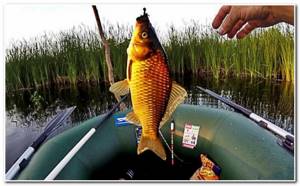
Equipment for fishing with a float rod
There is quite a wide variety of fishing gear. And this equipment may vary depending on the fishing location. Below are the essentials for catching crucian carp.
Important! Carbon rods are much stronger and more sensitive. They are most effective for catching crucian carp.
Rod
For a novice fisherman, a standard float rod, 7 m long, with a telescopic rod is suitable. It should be durable and light. Use it if the weather is warm and the crucian carp are in shallow water.
Take a bottom fishing rod with you if the fish are feeding in the bottom layer due to the cooling of the upper layers of water. The rod can also be telescopic. The equipment of both types of fishing rods is almost the same.
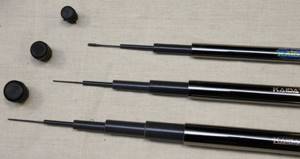
The main types of fishing rods and their features are described in the table.
| Fishing rod type | Key Features |
| Flywheel | A fly fishing rod is considered the most convenient for a novice fisherman. Its advantages:
But this model is inconvenient for fishing in deep layers, since the working distance is limited by the length of the rod, so use a fly rod in shallow waters. |
| Bolognese fishing rod | This is the most common type. It is equipped with guide rings and a spinning reel. With its help, you can cast the bait further and catch crucian carp at depth. But such a product weighs more than a flywheel, and is more difficult to equip. |
| Match fishing rod | Suitable for reservoirs with heavily overgrown bottoms. It can be cast at a distance of up to 60 m, which makes a large area available for searching for fish and allows you to count on a plentiful catch. |
| Picker fishing rod | Suitable for bottom fishing in small, clean reservoirs. This is a lightweight version of a feeder fishing rod. Casting distance - 30 m. |
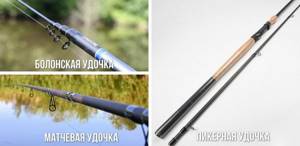
Float and its loading
For crucian carp you need a sensitive float. The most popular is the “goose feather”. It is quite light and able to respond to even the most careful bite. But if the wind blows, it sways from the movement of the waves, and it is almost impossible to determine whether the fish is biting. Therefore, stick to the classics - these are floats of the “spindle”, “drop”, “reverse drop” type, weighing up to 3 g.
Did you know? Crucian carp
of the golden and silver species are capable of interbreeding, forming hybrid offspring.
At the same time, such fish swim and feed longer than ordinary forms. Some fishermen make their own floats. To do this, they take a goose feather, clean it of fluff, shorten it, paint it in a bright color and put nipples on it, with which it is attached to the fishing line. Do the same with a cocktail tube, only the ends need to be sealed.

2-3 lead pellets are used as a sinker. They are placed next to each other. The distance between the hook and the weight should be about 20 cm. The technique of using it is that if you get a lot of unsuccessful bites, then the distance between the sinker and the hook is increased. And if a crucian carp eats the bait, but this does not affect the float in any way, then, on the contrary, they reduce it.
You might be interested in learning how to stew crucian carp in a frying pan and in a slow cooker.
Hook
For a typical small crucian carp, hooks No. 3–7 are used; for individuals weighing 2-3 kg, hooks No. 5-6 are used.
Basic product characteristics:
- curved forearm - it is necessary for the bait to hang naturally, since there is no prey in the water that is absolutely erect;
- material - steel;
- any color, but not variegated.
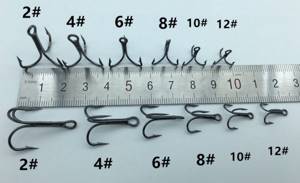
You need to set the bait so that the hook is hidden as much as possible. When putting on several layers of bait, there should not be too much of it - cautious crucian carp will not bite on a massive object. The same hook is enough for 2-3 fishing trips, after which it loses its sharpness, so it is not advisable to use it in the future.
You can put on two hooks at once. This is the right decision in cases where you are not sure that the bite will be successful. Then you can use different baits on both hooks, thereby increasing the chance of catching.
Find out also how to deliciously cook crucian carp in the oven.
Coil
A spinning reel or any inertial reel is suitable for a fly fishing rod. For equipment with long casting, only the first one is needed. But, in general, fishing for crucian carp does not have any special requirements for the reel.

Main characteristics of the product:
- width - 2–4 cm;
- spool - metal or graphite;
- number of bearings - 5-6;
- clutch - front.
Important! Using a heavy reel will make the rod heavier and less sensitive.
Line and leash
Monofilament or fluorocarbon fishing line is suitable for crucian carp. The first is made of polymers and has high elasticity and rigidity. The second is also polymer, but more modern. Its peculiarity is that it is almost invisible in the water, but its disadvantage is that it cannot support large fish.
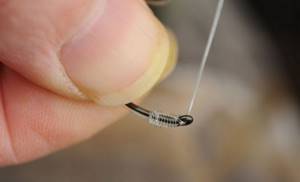
Main parameters of the fishing line:
| Diameter | 0.1–0.14 mm. The thinner the line, the less noticeable it is and the more often the bites. |
| Color | Gray or brown for an overgrown pond, colorless for a clean one. |
Carp can easily bite the fishing line. To prevent this, a leash is placed between the hook and the thread. For a float fishing rod, its length should be between 15–30 cm. If we are talking about a feeder, 20–80 cm. The shorter it is, the greater the resistance of the tackle and the higher the likelihood that the fish will not bite.
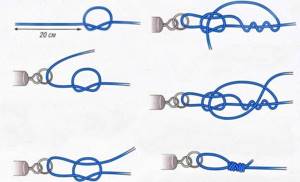
Fishermen explain the need for a leash by saying that crucian carp can be capricious and not take the bait. But the situation changes when installing a leash. Whether this is true or not, everyone is convinced from their own experience.
Autumn bait for crucian carp
The object of fishing is known for its omnivorousness, but it is not always pleasing with it. Its appetite is affected by weather conditions and water temperature. At the very beginning of autumn, while the warm sunny weather continues, crucian carp are still interested in vegetable baits: semolina, mastyrka, barley, corn, white bread and others. But as soon as the first autumn rains begin and the nights become cold, all of the above baits become ineffective. Up to a certain point, the silver beauty, of course, will peck at them, but not as much as we would like. Therefore, with the arrival of cold weather, you should switch to animal baits - worms and maggots, and in late autumn to bloodworms.
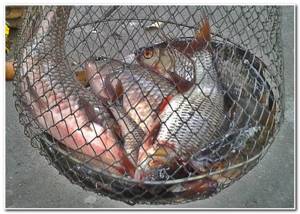
Feeding
Success in catching crucian carp with a fishing rod in the fall largely depends on bait, especially in September, when it is still actively feeding and reacting to strong odors. For example, vanilla. At this time, a plant base is used to create an attractive mixture, but as the water cools, the nutritional value of the bait must be reduced. On cool days, the symbiosis of chopped worms with macadamia works well, and in the second half of autumn it is advisable to use only live ingredients mixed with clay for feeding. The same chopped worms, food bloodworms or small maggots of pink will do. It is better to underfeed autumn crucian carp a little rather than overfed, otherwise it will stop responding to the bait.
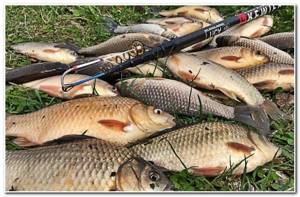
Tackle and process of catching crucian carp in autumn
The floats and the tackle itself should be as sensitive and light as possible. That is why, sometimes it makes sense to place floats without a sinker (the nozzle creates weight), or to place the sinkers correctly so that the crucian does not experience any effort when biting. Crucian carp bites very carefully in the fall, without jerking or sudden movements; the float may twitch slightly, move slowly to the side, and stick out slightly from the water. Beginner fishermen may not notice the autumn bite.
The use of leashes is mandatory, and you need to strive to ensure that the hooks from the sinker are at a distance of at least 30 centimeters - the fish are cautious in the fall and get scared of everything.
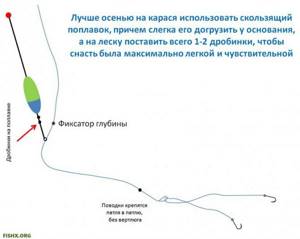
The fishing rod should always be placed on a stand in the fall, and if the float is blown away by the wind or current, simply reduce the arc of the free line. If the crucian carp does not bite the bait, donks are used - so you need to try all the methods. In general, you need to strive to ensure that the gear is close to winter: small hooks, thin fishing line (0.1-0.15mm), a minimum of weight, soft baits and bait (bloodworms). All the best to you.
Share with your friends!
